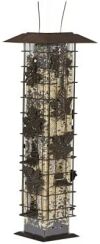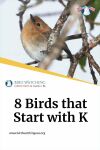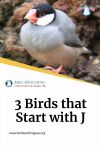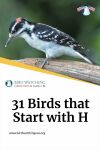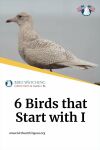
Introduction
How many common birds are there in the USA and Canada? Well, around 750 and out of those, there only 6 that start with the letter I! These birds make up around 0.8% of the total so they could be pretty hard to find. But being a bird lover, I had to learn more about them and share my findings with the other bird lovers - which also includes you!
Luckily for me, I wasn’t alone. Thanks to the data at eBirds.com, I was able to put together a list in descending order. These birds beginning with the letter I have been seen by bird watchers like us, who then shared their findings on the platform.
So before we dive into the details, here’s a quick chart of these birds!
| Indigo Bunting | 5.11% |
|---|---|
| Inca Dove | 0.64% |
| Iceland Gull | 0.28% |
| Iiwi | 0.04% |
| Indian Peafowl | 0.02% |
| Island Scrub-Jay | 0.01% |
Let’s see how each bird looks, along with birdwatching tips that’ll make sure you can spot them too!
1. Indigo Bunting
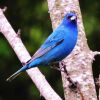
We have the stunning Indigo Bunting at #1!
You can find this bird foraging almost everywhere. Be it on the ground, in the bushes and shrubs, or even in the trees. Its diet is made up entirely of seeds and insects. In the winter, you can find this bird having an appetite mostly for plants. During the summer, I saw it alone but in the winter, I found these blue-feathered birds in flocks.
These birds are attracted to bird feeders very easily. You can fill them with seeds or even put in berries if you have them in your backyard. Although that’s just an option since they go to shrubs directly. Also, if you have worms in your backyard, then you have even more chances of finding these birds!
When trying to recognize it by sound, pay attention to its warbling notes. It sings and chirps multiple times, as phrases. Oh, and did you know another cool fact about these birds? They don’t have blue pigment. Instead, their vivid blue color comes from the structures in their feathers that cause the emission of blue light, quite similar to how we see the sky blue!
fun fact
navigation using stars
Indigo buntings use the stars for guidance. So their migration takes place at night! Indigo buntings have the tendency to adjust their angles according to the stars changing in the night sky.
Don’t have bird food? Here’s one that I highly recommend.
Wagner's 52001 Classic Blend Wild Bird Food
This 5-pound bag of wild bird food is all you need. It consists of sunflower and other sunflower seeds.
2. Inca Dove
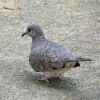
On #2 we have the stunning Inca dove! It’s easy to find these doves in the Southwest of the United States. But that’s not all, since they constantly expand their range, they like living near people too. So that’s the good news when it comes to finding these birds in the cities. These birds have beautiful texture on their feathers, which truly makes them stand out from the crowd.
These doves are so easy to attract to bird feeders! Moreover, if your backyard is full of shrubs and plants, you can expect them in flocks. You can even attract a breeding pair in that case because these doves love to build their nests in dense foliage.
You can easily find them foraging on the ground, whether it’s full of grass or only soil. They even feed on grit or gravel because it helps them digest seeds better. Since their diet is mostly made up of seeds, it makes all the more sense!
Their calls and songs are similar to any dove. Keep your ears open to the sound of coo-coo around you. Their song even sounds like they’re repeating the phrase “no hope” over and over again.
fun fact
notice the color of their eyes
Their eyes are naturally red. However, if you find them getting brighter, it simply means that they probably feel threatened.
3. Iceland Gull
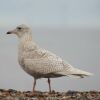
The best place to look for these gulls is along the coastlines of the Atlantic and Pacific oceans. The Great Lakes are also a good place to look for these birds. But if you want to take it one step further, then you can even take a trip to the Arctic ocean.
The best way to recognize Iceland Gulls is to pay close attention to their wingtips. It was quite surprising for me when I noticed firsthand how the colors of their wings can vary from the East to the West. In the East, I noticed that the Iceland Gulls had faded grey and white wingtips. But when I moved toward the West, I noticed that the tips of their wings were black instead. They even had darker eyes in the latter region.
Iceland gulls forage by dipping their bills into the water or going deeper. As you can imagine, their diet is mostly made up of fish, mollusks, and crustaceans. However, they don’t mind eating a couple of seeds and berries now and again either.
And if that’s not all, you can even find them hovering around garbage dumps and feeding on eggs of other birds, and even their dead bodies. Also pay attention to their squeaking, croaking, or screaming as they’re moving above the waters or otherwise.
fun fact
the oldest iceland gull
The oldest age recorded for an Iceland Gull is 4 years and 8 months. It was spotted in Eastern Canada, healthy and alive.
By the way, if you’re looking for a bird feeder to attract other birds to your backyard, I suggest you get this one .
Perky-Pet 336 Squirrel-Be-Gone Wild Bird Feeder
This 2-pound beige-colored bird feeder holds up to 2 pounds of seed and keeps the squirrels away too!
4. Iiwi
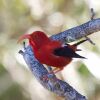
The Iiwi is a honeycreeper bird that is found abundantly in the Hawaiian Islands. It’s an absolute delight to watch this stunning honeycreeper flutter its scarlet feathers. It is a very common forest bird and even though its quantity is declining, you can find these birds easily in dense wet forests.
Their long bills are as unique as their bright red outlook. When I was on a vacation in Hawaii, I was lucky enough to spot an I’iwi bird reaching deep down into the flower to suck its nectar. Their most favorite are the mint flowers, however, you can also find them moving towards the ōhiʻa tree’s flowers as well. These trees are native to the islands of Hawaii.
All in all, your best bet to find these birds is at a high altitude. Plan a vacation to the Hawaiian Islands and find them in abundance across Maui, Hawai’i, Moloka’i, O’ahu, and even Kaua’i.
fun fact
Sacred identity
Like many Hawaiian birds, the I'iwi was also considered to be sacred in the ancient culture of Hawaii. This is due to the fact that early Hawaiians used to see red as a sacred color, especially in birds.
5. Indian Peafowl
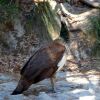
Yes, we have the Indian Peafowl on #5! Although it’s native to the Indian subcontinent, you can find these birds in the USA and Canada. It’s so simple to spot these birds because of their huge size and how they are always foraging on the ground.
The only thing you have to do is to distinguish between the male and female Indian peafowls. The male (peacock) typically has a long train-like trail of feathers going behind him. Whereas, the female (peahen) doesn’t have such long trailing feathers but you can recognize them from the green feathers on the bottom half of its neck.
Their brown feathers are also duller compared to their male counterparts. To tell the young male Indian peafowls apart from the females, look for a chestnut brown color on their chest. They’ll be louder than usual during the breeding season, so listen for
During morning hours, you’ll find them wandering in the open fields. But in the afternoon they take refuge from the scorching heat. At dusk, they come out openly once again and you’ll often find them saying ‘pea-ow’ out loud.
When it comes to flight, both peacocks and peahens have the same capacity and ability to fly.
fun fact
European hsitory
There are two theories as to how the Indian Peafowl reached Europe. Some say that it was Alexander the Great that brought it with him. While the other theory suggests that they might have come in earlier, around 450 BC, in Athens.
6. Island Scrub-Jay
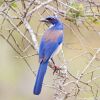
The only way to see these birds is by planning a visit to Santa Cruz Island. So it’s no wonder that this blue beauty is also known as the ‘Island’ Scrub-Jay! It’s not that hard to find these birds because they forage both on the ground and in the trees.
Since they are omnivorous, you’ll find that they have a vast appetite. Although it varies from one season to another, you’ll find them mostly eating acorns, seeds, and berries in plants. And when it comes to non-vegetarian food, they love to feed on reptiles such as lizards and mice. You’ll be surprised to know that they eat small snakes and even the eggs of other birds!
fun fact
longevity and monogamous nature
The Island Scrub-Jay lives as long as 20 years! Moreover, they are seriously monogamous and spend their life with only one partner.
Conclusion
So there you go. Those are the 6 most common birds that start with the letter I and are found in the USA and Canada. Have you had the chance to see any of these birds before? If not, then which ones do you plan to watch first? Remember our birdwatching tips and watch this space for more.
Also, read this post if you want to learn about the most common birds that start with j !
3 Birds that Start with J
Did you know that out of the 750 most common birds in the USA and Canada, there are only 3 that start with the letter J? Here's the complete list!

By David A. Swanson
Bird Watching USA
My name is David and I'm the the founder of Bird Watching USA! I started Bird Watching with My father-in-law many years ago, and I've become an addict to watching these beautiful creatures. I've learnt so much over about bird watching over the years that I want to share with the world everything I know about them!

David A. Swanson
Bird Watching USA
My name is David and I'm the the founder of Bird Watching USA! I started Bird Watching with My father-in-law many years ago, and I've become an addict to watching these beautiful creatures. I've learnt so much over about bird watching over the years that I want to share with the world everything I know about them!


